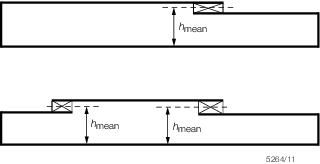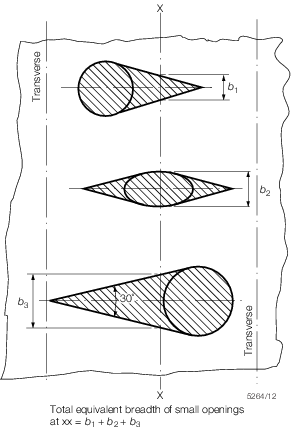2.2.1 Section
modulus calculations are required on all pontoons with an L/D > 6.
2.2.2 All
continuous longitudinal structural components are to be included in
the calculation of the inertia of the pontoon midship section, where
appropriate, and the lever z is to be measured vertically
from the neutral axis to the top of bottom plating and to the moulded
strength deck line at the side. Where the deck is stepped the hull
section modulus for sections between the deck overlaps may be calculated
using a mean height h
mean, as indicated in Figure 4.2.1 Stepped decks. If the deck thickness
varies between the stepped decks, the lesser value is to be used in
the calculation of section modulus.

Figure 4.2.1 Stepped decks
2.2.3 Deck
openings having a length in the fore and aft directions exceeding
2,5 m or a breadth exceeding 1,2 m or 0,04B m, whichever
is the lesser, are always to be deducted from the sectional areas
used in the section modulus calculation.
2.2.5 In
the calculation of deduction-free openings, the openings are assumed
to have longitudinal extensions as shown by the shaded areas in Figure 4.2.2 Deduction-free openings. The shadow area
is obtained by drawing two tangent lines to an opening angle of 30°.
The section to be considered should be perpendicular to the centreline
of the pontoon and should result in the maximum deduction in each
transverse space.
2.2.6 Isolated
openings in longitudinals or longitudinal girders need not be deducted
if their depth does not exceed 25 per cent of the web depth with a
maximum depth for scallops of 75 mm.
2.2.7 Openings
are considered isolated if they are spaced more than 1 m apart in
either the transverse or longitudinal direction.

Figure 4.2.2 Deduction-free openings
2.2.8 Deck
openings should be avoided in areas of high stress.